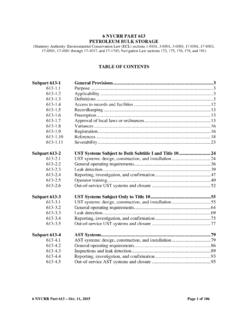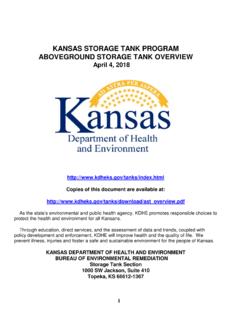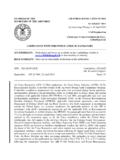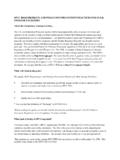Transcription of FACILITY OWNERS/OPERATORS GUIDE TO SPILL …
1 FACILITY OWNERS/OPERATORS GUIDE TO SPILL prevention , control , AND COUNTERMEASURE (SPCC) PLANS Materials Provided by the Independent petroleum Association of America 1201 15th Street, NW Suite 300 Washington, DC 20005 (202) 857-4722 Fax: (202) 857-4799 Understanding the SPILL prevention , control and Countermeasure (SPCC) Requirements 2 Independent petroleum Association of America 1201 15th Street, , Suite 300 Washington, DC 20005 (202) 857-4722 Fax (202) 857-4799 TABLE OF CONTENTS RULE PAGE 3 APPLICABILITY ASSESSMENT 4 APPLICABILITY OF THE SPCC PAGE 5 DETERMINATION OF PAGE 7 DEFINING NAVIGABLE PAGE 8 CALCULATING OIL STORAGE PAGE 11 COMPLIANCE PAGE 12 DETERMINATION OF 12 PREPARATION OF SPCC PAGE 14 CERTIFICATION OF SPCC PAGE 15 VIOLATION 16 REQUEST FOR ADDITIONAL PAGE 17 APPENDIX I: APPLICABILITY ASSESSMENT PAGE 19 APPENDIX II: NEGATIVE DECLARATION PAGE 21 APPENDIX III: TIER I AND II QUALIFIED FACILITY ELIGIBILITY REQUIREMENTS AND PAGE 23 APPENDIX IV: TIER I QUALIFIED FACILITY SPCC PLAN 25 APPENDIX V: CERTIFICATION OF THE APPLICABILITY OF THE SUBSTANTIAL HARM PAGE 47 APPENDIX VI: SPCC FIELD INSPECTION AND PLAN REVIEW CHECKLIST.
2 PAGE 49 Understanding the SPILL prevention , control and Countermeasure (SPCC) Requirements 3 Independent petroleum Association of America 1201 15th Street, , Suite 300 Washington, DC 20005 (202) 857-4722 Fax (202) 857-4799 Rule Summary In 2002, the Environmental Protection Agency (EPA) amended the Oil Pollution prevention regulation (40 CFR part 112), which includes requirements for specific facilities to prepare or amend, and implement SPILL prevention , control , and Countermeasure (SPCC) Plans. The SPCC rule carries out EPA s authority under the Clean Water Act (CWA) 311. The SPCC requirements for production facilities date back to 1973. The rule requires facilities, meeting certain oil storage thresholds, which could reasonably be expected to discharge oil in quantities that may be harmful into navigable waters of the United States or adjoining shorelines to develop and implement SPCC Plans as well as train employees to carry it out.
3 The Plans ensure that these facilities put in place containment and countermeasures that will prevent oil discharges. Since 2002, EPA has revised the rule several times, with final amendments to the SPCC Rule in November 2009. The rule amendments address areas of regulatory reform that had been raised by the regulated community. The most recent final rule amendments went into effect on January 14, 2010. This document is a condensed summary of the rule and provides information specific to oil and natural gas production. Any decisions made regarding the rule are ultimately the responsibility of the owner or operator of each FACILITY . Owners or operators requesting more specific information should reference the contact information provided on page 17. Understanding the SPILL prevention , control and Countermeasure (SPCC) Requirements 4 Independent petroleum Association of America 1201 15th Street, , Suite 300 Washington, DC 20005 (202) 857-4722 Fax (202) 857-4799 SPCC Applicability Assessment Flowchart Is the FACILITY or part of the FACILITY ( complex) considered non-transportation-related?
4 (Page 6) Is the FACILITY engaged in drilling, producing, gathering, storing, processing, refining, transferring, distributing, using, or consuming oil? (Page 5) Could the FACILITY reasonably be expected to discharge oil in quantities that may be harmful into navigable waters or adjoining shorelines? (Page 8) Is the total aggregate capacity of aboveground oil storage contains greater than 1,320 gallons of oil? (Page 11) (Do not include containers less than 55 gallons, permanently closed containers, or storage containers used exclusively for wastewater treatment) or Is the total aggregate capacity of completely buried storage tanks greater than 42,000 gallons of oil? (Page 11) (Do not include completely buried tanks subject to all technical requirements of 40 CFR 280/281, containers less than 55 gallons, permanently closed containers, or storage containers used exclusively for wastewater treatment) The FACILITY IS subject to SPCC.
5 The FACILITY IS NOT subject to SPCC. Yes Yes Yes Yes No No No No Understanding the SPILL prevention , control and Countermeasure (SPCC) Requirements 5 Independent petroleum Association of America 1201 15th Street, , Suite 300 Washington, DC 20005 (202) 857-4722 Fax (202) 857-4799 Applicability of the SPCC rule Facilities that are subject to the SPCC rule: 1. Have an aggregate aboveground oil storage capacity greater than 1,320 US gallons or completely buried oil storage capacity greater than 42,000 US Gallons; and 2. If a SPILL would occur, there is a reasonable expectation of an oil discharge into or upon navigable waters or adjoining shorelines, in an amount causing harm (for example a sheen). Examples of facilities and operations covered by the SPCC rule: Onshore and certain offshore oil well drilling and workover facilities; Onshore and certain offshore oil production facilities (including separators and storage facilities); Loading racks, transfer hoses, loading arms, and other equipment; Vehicles ( tank trucks) and railroad cars used to transport oil exclusively within the confines of a FACILITY ; and Pipeline systems used to transport oil exclusively within the confines of a FACILITY .
6 A FACILITY that stores, processes, refines, uses or consumes oil and is non-transportation-related is potentially subject to the SPCC rule. Under the rule, FACILITY means any mobile or fixed, onshore or offshore building, structure, installation, equipment, pipe, or pipeline (other than a vessel or a public vessel) used in oil well drilling production, oil refining, oil storage, oil gathering, oil processing, oil transfer, or in which oil is used. The boundaries of a FACILITY depend on several site-specific factors, including, but not limited to, the ownership or operation of buildings, structures, equipment on the same site and the activity at the site. The FACILITY owner or operator, or a Professional Engineer (PE) on behalf of the FACILITY owner/operator, determines what constitutes the boundaries of the FACILITY . Examples of facilities excluded from the SPCC rule: Any FACILITY where the oil storage capacity of completely buried storage tanks and associated piping and equipment does not exceed 42,000 gallons and the aggregate aboveground oil storage capacity does not exceed 1,320 gallons; Completely buried tanks and associated piping and equipment that are subject to all of the technical requirements under 40 CFR part 280 or 281; Any container with a storage capacity less than 55 gallons at a FACILITY ; Any FACILITY or part thereof used exclusively for wastewater treatment; The capacity of any permanently closed oil storage container; Interstate or inter- FACILITY oil pipeline systems; Oil transported in vessels ( ships, barges); and Oil transported between facilities by rail car or tanker.
7 Understanding the SPILL prevention , control and Countermeasure (SPCC) Requirements 6 Independent petroleum Association of America 1201 15th Street, , Suite 300 Washington, DC 20005 (202) 857-4722 Fax (202) 857-4799 Any FACILITY or part thereof used exclusively for wastewater treatment and not used to satisfy any requirement of the SPCC rule is exempt. The production, recovery, or recycling of oil is not wastewater treatment. For the purposes of the wastewater treatment exemption, produced water is not considered wastewater, and treatment of produced water is not considered wastewater treatment. Therefore, a FACILITY that stores, treats, or otherwise uses produced water remains subject to the rule. Oil/water separators used exclusively to treat wastewater are exempt from all SPCC requirements. Oil/water separators used in oil production and to meet the secondary containment requirements of the rule are not exempt.
8 Dry gas production facilities are typically not subject to the SPCC rule. A dry gas production FACILITY produces natural gas from a well but does not also produce condensate or crude oil that can be drawn off the tanks, containers, or other production equipment at the FACILITY . However, if petroleum products are stored on site in excess of the SPCC thresholds and meet the other applicability criteria, they may be required to develop an SPCC plan. It is incumbent on the operator to verify that a particular gas FACILITY is not an oil production, oil recovery, or oil recycling FACILITY by providing evidence pertaining to: Presence or absence of condensate or crude oil that can be drawn off the tanks, Oil containers or other production equipment at the FACILITY , Pertinent FACILITY test data and reports ( , flow tests, daily gauge reports, royalty reports or other production reports required by state or federal regulatory bodies).
9 Wet gas production facilities may be subject to the SPCC rule if they meet the applicability criteria. In addition to natural gas, wet gas production facilities produce condensate or crude oil that can be drawn off the tanks, containers, or other production equipment at the FACILITY . Since wet gas production facilities produce and store condensate, which is considered oil, they are regulated under the SPCC rule. Permanently closed containers are not counted when calculating total oil storage capacity. Permanently closed, as defined in , refers to containers for which (1) All liquid and sludge has been removed from each container and connecting line; and (2) All connecting lines and piping have been disconnected from the container and blanked off, all valves (except for ventilation valves) have been closed and locked, and conspicuous signs have been posted on each container stating that it is a permanently closed container and noting the date of closure.
10 Operations that are intended to move oil from one location to another, transportation-related, are not included. EPA regulates tank trucks as mobile/portable containers under the SPCC rule if they operate exclusively within the confines of a non-transportation-related FACILITY . For example, a tank truck that moves around within the FACILITY and only leaves the FACILITY to obtain more fuel (oil) would be considered to distribute fuel exclusively at one FACILITY . This tank truck would be subject to the SPCC rule if it, or the FACILITY , contained above the regulatory threshold amount and there was a reasonable expectation of discharge to navigable waters or adjoining shorelines. However, if the tank truck distributed fuel to multiple off-site facilities, the tank Understanding the SPILL prevention , control and Countermeasure (SPCC) Requirements 7 Independent petroleum Association of America 1201 15th Street, , Suite 300 Washington, DC 20005 (202) 857-4722 Fax (202) 857-4799 truck would be transportation-related, and regulated by the Department of Transportation.







